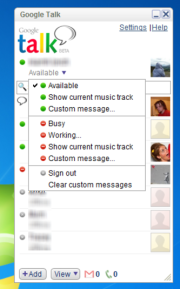Why You Don't Need to Work in an Office Ever Again
Posted: June 19, 2012
 Some days "going to the office" can fill you with dread. If you've ever had one of those days, cheer up. You may be able to give yourself the tools that you need to be able to skip going to the office, and working remotely.
Some days "going to the office" can fill you with dread. If you've ever had one of those days, cheer up. You may be able to give yourself the tools that you need to be able to skip going to the office, and working remotely.
 Some days "going to the office" can fill you with dread. If you've ever had one of those days, cheer up. You may be able to give yourself the tools that you need to be able to skip going to the office, and working remotely.
Some days "going to the office" can fill you with dread. If you've ever had one of those days, cheer up. You may be able to give yourself the tools that you need to be able to skip going to the office, and working remotely.
The virtual workforce. Telecommuting. Mobility baked into everything. The cloud.
Nearly all the big trends facing small companies doing business in the '10s speak to the increasing irrelevance of one of the hallmarks of the working world: the office.
We’ve all worked there, whether we had an individual office with a window and a door, or just a small patch of carpet in a sea of cubicles. And generally an office isn’t a bad place to spend the day: It has climate control, an IT department to fix problems, and sometimes even free coffee. But most of all, offices offer camaraderie, and the chance for employees to have impromptu meetings and bounce ideas off one another.
Unfortunately, offices are also terribly, terribly expensive. Even in the down economy, real estate in a prime area such as midtown Manhattan can cost $50 per square foot per month and up, and that’s not including utilities, furniture, and build-out expenses.
So maybe you don’t need an office after all. With a largely mobile workforce that is often working from home, a car, or a nearby café, what’s the point of stocking a fridge that no one will ever use? Why not ditch the office for good and go 100 percent office-free?
Many people already do this, but if your job involves more than just tapping away on your laptop and making the occasional phone call, running a company without an office can be challenging.[caption id="attachment_10260" align="alignright" width="180"] Instant messaging services, such as Google Talk or AIM, are great tools for communicating with--and keeping track of--far-flung employees.[/caption]
Instant messaging services, such as Google Talk or AIM, are great tools for communicating with--and keeping track of--far-flung employees.[/caption]
Here are the big issues--and how to address them.
Dealing With Employees
Instant messaging services, such as Google Talk or AIM, are great tools for communicating with--and keeping track of--far-flung employees.
One of the biggest fears that many employers have about telecommuting is the worry that remote employees won’t do their jobs. Leave staffers alone at home all day, and they’ll just watch TV, do the laundry, or play hooky, leaving you to foot the bill for a day off. Those concerns seem to be misplaced, however. In fact, some studies have shown that employees who have more flexibility (including telecommuting options) work harder and longer than if they were at the office. This is why many employers are happy to outfit their staff with smartphones and laptops: A mobile device makes it incredibly easy to take your work home with you.
Of course, managing remote employees isn't always smooth sailing, and it's quite possible that your key people will decide to take a long lunch when you need them the most. The solution is largely one of setting expectations. Even if your employees are never in the office, they need to know that you expect them to act as if they were. Set working hours and a specific lunchtime if necessary, and require your staff to stick to the schedule. This policy should be in writing, either in a person's offer letter or as part of your employee handbook. If employees can't stick to the schedule for some reason, tell them that they need to let you know well in advance. An office employee wouldn’t think of leaving for a doctor’s appointment without notifying the boss, and there’s no reason a remote worker should do so either.
Making the rules of remote working crystal clear should mitigate most management problems.
Communication
Another big challenge with remote work involves communicating. [caption id="attachment_10265" align="alignleft" width="350"] OoVoo offers an inexpensive videoconferencing service for as many as 12 participants; in fact, it's free if you can tolerate ads.[/caption]You can’t just walk over and drop a file on a junior staffer’s desk or round up a few people for a quick meeting. So how do you keep in touch, and keep everyone on the same page?
OoVoo offers an inexpensive videoconferencing service for as many as 12 participants; in fact, it's free if you can tolerate ads.[/caption]You can’t just walk over and drop a file on a junior staffer’s desk or round up a few people for a quick meeting. So how do you keep in touch, and keep everyone on the same page?
Instant messaging has been the communications medium of choice for most virtual or far-flung organizations. Choose a platform, and require all staffers to sign in to their account at the beginning of each workday. If employees aren’t going to be available for a while, whether it’s for lunch or other duties, have them update their IM status to reflect where they are and when they’ll be back.
![]() OoVoo offers an inexpensive videoconferencing service for as many as 12 participants; in fact, it's free if you can tolerate ads.Of course, having a workable phone network is critical too. Although many people have forsaken landlines these days, if employees’ cell phone reception isn’t perfect, they’ll need to change networks, acquire a VoIP system, or even invest in old-school wires. As a small-business owner, you may have to pay for some or all of this expense.
OoVoo offers an inexpensive videoconferencing service for as many as 12 participants; in fact, it's free if you can tolerate ads.Of course, having a workable phone network is critical too. Although many people have forsaken landlines these days, if employees’ cell phone reception isn’t perfect, they’ll need to change networks, acquire a VoIP system, or even invest in old-school wires. As a small-business owner, you may have to pay for some or all of this expense.
If you want to get really advanced, you can look into having group video chats with your staff. OoVoo supports video chats with up to 12 participants (free with ads; $3 per user per month without ads). Skype Premium supports up to 10 simultaneous participants for $5 per user per month. Just make sure everyone has a very fast network connection.
Biz Tip Provided by PCWorld
Written By Christopher Null